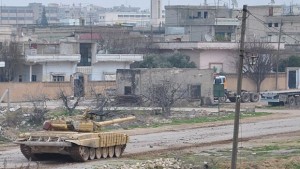Special to WorldTribune.com
NICOSIA — President Bashar Assad has launched what the opposition
termed a sustained counter-insurgency campaign to quell the revolt
throughout Syria.
Meanwhile, defectors reported exhaustion within the Assad regime which, on Feb. 7, was scheduled to conduct high-level consultations with the Kremlin. Russian Foreign Minister Sergei Lavrov said
he and Foreign Intelligence Service head Mikhail Fradkov would arrive in
Damascus.

Opposition sources said Assad approved a plan in which some 30,000 soldiers from the Syrian Army and Republican Guard would be engaged in attacking suspected rebel strongholds. They said the first stage of the operation took place in Homs in early February, in which about 350 people were killed in one day.
“What took place in Homs and Zabadani was meant to test the feasibility of this plan,” opposition spokesman Ahmed Ramadan said. “The campaign will now be escalated.”
Still, the Syrian Army is said to have performed poorly in operations against the rebels, particularly in fighting in the suburbs of Damascus. The sources said the failure of the Syrian Army has sparked tension within the regime leadership, particularly between Assad’s younger brother, Maher, and Col. Hafez Makhlouf, a leading officer in the General Security Directorate.
A Syrian Army general who defected, Mustafa Al Sheik, said the Assad
regime, despite intensified operations, was becoming exhausted. Al
Sheik said the regime could collapse within weeks because of a shortage of
resources.
“The Army will collapse during February,” Al Sheik told the British
newspaper Telegraph. “The reasons are the shortage of Syrian Army personnel,
which even before March 15, 2011 did not exceed 65 percent. The proportion
of equipment that was combat-ready did not exceed that, due to a shortage of
spare parts.”
Al Sheik estimated that Syrian Army combat readiness has dropped to 40
percent for equipment and 32 percent for personnel. He said the regime was
trying to compensate by recruiting Alawite fighters, particularly the
Shabiha militia.
“But this Army is unable to continue more than a month,” Al Sheik said.
“Some elements of the Army are reaching out to the Free Syrian Army to help
them to defect.”
Ramadan, chief information officer of the Syrian National Council, said
the Assad regime plans to regain control of rebel-held areas along the
borders of Jordan, Lebanon and Turkey. He said the first stage of the
military operation, aided by Iran and Russia, lasted five days and focused
on such rebel-held cities of Aleppo, Homs, Idlib, Rastan and Zabadani.
“We have credible information that confirms that senior meetings were
held in the framework of the military operations command, which manages the
campaign for the regime,” Ramadan said.
The military command was said to consist of five regime leaders and
commanders. Ramadan said the units selected for the CI operation included
the Army’s 4th Division, 5th Division, the Republican Guard as well as
special operations units.
Ramadan did not cite the source of his information. SNC, linked to the
Muslim Brotherhood, was said to have access to Sunni commanders in the Army
and security forces.
The sources said the regime planned to sustain the CI campaign by
deploying at least 2,000 troops for daily operations. They said the campaign
intensified missions along the Syrian border towns of Ain Al Beida and
Khirbet Al Joz in which gunfire struck homes in Turkey’s Hatay province.

You must be logged in to post a comment Login